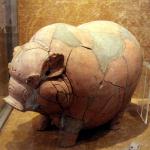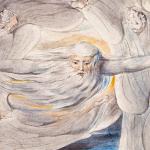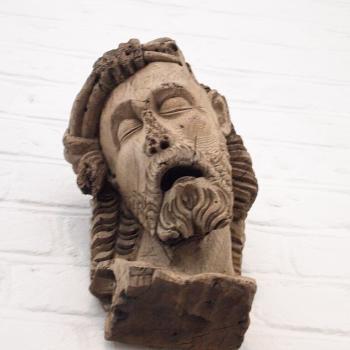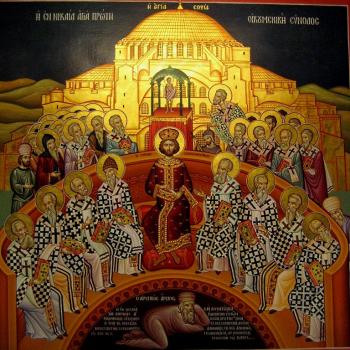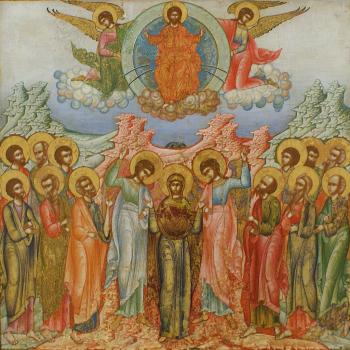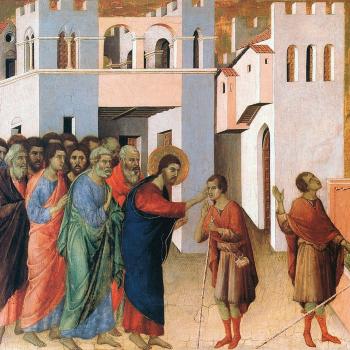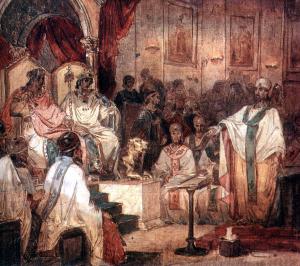 One of the great difficulties of Christology is showing how Jesus Christ is said to be one, following what Scripture indicated of him: “There is one body and one Spirit, just as you were called to the one hope that belongs to your call, one Lord, one faith, one baptism, one God and Father of us all, who is above all and through all and in all” (Eph. 4:4-6 RSV). When looking at him, we see one person, but when we discern who he is in that person, we find he is one person with two natures, God and human. This is where confusion and debate springs up. How is Jesus said to be one in a way which does not destroy the notion that there is but one Lord and yet which does not merge or confuse the two natures of God and man in one fashion or another, causing either the divinity to change into something it is not or for the humanity to lose itself entirely in his divinity?
One of the great difficulties of Christology is showing how Jesus Christ is said to be one, following what Scripture indicated of him: “There is one body and one Spirit, just as you were called to the one hope that belongs to your call, one Lord, one faith, one baptism, one God and Father of us all, who is above all and through all and in all” (Eph. 4:4-6 RSV). When looking at him, we see one person, but when we discern who he is in that person, we find he is one person with two natures, God and human. This is where confusion and debate springs up. How is Jesus said to be one in a way which does not destroy the notion that there is but one Lord and yet which does not merge or confuse the two natures of God and man in one fashion or another, causing either the divinity to change into something it is not or for the humanity to lose itself entirely in his divinity?
St. Cyril of Alexandria was one of the greatest writers on the unity or oneness of Christ because of the force by which he professed that unity. His focus throughout his debate with Nestorius was to show how there was one Son of God, one Lord who Christians worshiped who is the eternal Logos that assumed human nature and became man. St. Cyril consistently discussed the differences between Jesus’ divinity and humanity, affirming those differences as continuing after the incarnation, so he would be able to say the one Lord Jesus Christ, God, died on the cross, suffering only in relation to his humanity while being impassible in his divinity. Because the theological distinction between person and nature had yet to be fully understood and accepted in his time, St. Cyril at times would speak loosely of the one “incarnate nature” (phusis) of Jesus while, meaning (as he would often use in the same theological discussion) one person or hypostasis. Like the Fathers at Nicea, St. Cyril often used the two in equivocal fashion. Antiochians in his time were beginning to understand and establish a distinction between nature and person, phusis and hypostasis; understanding their meaning, St Cyril was able to say he fully agreed with their position, such as when he wrote:
But the brethren at Antioch, understanding in simple thoughts only those from which Christ is understood to be, have maintained a difference of natures, because, as I said, divinity and humanity are not the same in natural quality, but proclaimed one Son and Christ and Lord as being truly one; they say his person is one, and in no matter do they separate what has been united. Neither do they admit the natural division as the author of the wretched inventions was pleased to think, but they strongly maintain only the sayings concerning the Lord are separated, not that they say some of them separately are proper to the Son, the Word of God the Father, and others are proper to another son again, the one from a woman, but they say that some are proper to his divinity and others are again proper to his humanity. For the same one is God and man. But they say that there are others which have been made common in a certain way and, as it were, look toward both I mean both the divinity and the humanity.
What I am saying is the same as this.[1]
Some, trying to follow St. Cyril, did so through his vocabulary more than with his meaning; they tried to enforce his “one incarnate nature” after the incarnation as a way to justify the so-called “monophysite” position. They did this by declaring that there is only one nature for Jesus Christ after the incarnation, confusing therefore, the natures in the way St. Cyril did not. That St. Cyril was able to write and affirm the Antiochian position indicated his meaning was opposed to this reductionism and why his writings would later be employed by St. Leo the Great in defense of his Tome against Eutyches. St. Cyril did not want to confuse or mix the natures of Christ, he only wanted to affirm that there is but one Lord, one Son of God, who was begotten of the Father before all ages and who also assumed human nature, a body with a rational soul, and became a man born of the Virgin Mary while remaining as he was, God over all.
Thus, Jesus is the name given to the Divine Logos as he assumed human nature and became man, taking all that is authentic to human nature upon himself. There is but one person, one hypostasis, begotten of the Father before all worlds, who assumed human nature and became man, not by a change in his divine nature, but in the assumption of humanity to his own person. There is no other person associated with that humanity – there is no union of two persons becoming one; there is no assumption of a human person to the Divine Logos.
The question which develops from this is simple: did the Logos assume a generic humanity? How can he be seen as a particular man, who lived and died and rose again in particular times and places, if he is not a human person?
The theological answer which developed to explain this is to say there is no generic humanity without some instantiation, some person, to hold it and particularize it; but that person does not have to be a human person, but rather, human or something which transcends a human person and so can contain it. The Logos, being divine, can infinitely comprehend humanity and so take on and assume humanity with the hypostasis which instantiates the humanity being the Divine Logos. The humanity is said to be enhypostasis, for it needs no human person in order for it to be particularized; it is particularized in the higher hypostasis of the Divine Logos, so that the space for that person is taken by the Divine Person.
This, for many of us, seems rather odd. The perfect human is not a human person; the perfect human has no specific human self. While this is a mystery which is difficult for us to grasp, we can see some interesting things which flow from it, which point to the truth of the incarnation and what we know of It. He is in his humanity able to be seen as lowly and of no account, for in the incarnation, the Logos emptied himself so as to become man whose humanity is entirely dead to the self. There is no human selfishness, no humanized egotism. [2] With no humanized self, he shows the perfection of human nature, capable of being fully and perfectly selfless in his loving compassion. He has no human self from which he can prop up any and all kind of self-assumed glory. Likewise, as he takes on the sins of the world upon himself, there is no self on which they can hold on to and contaminate. He who is the greatest man is perfectly selfless to the end, so that despite being God, he did not grasp for and hold on to his divinity:
Have this mind among yourselves, which was in Christ Jesus, who, though he was in the form of God, did not count equality with God a thing to be grasped, but emptied himself, taking the form of a servant, being born in the likeness of men. And being found in human form he humbled himself and became obedient unto death, even death on a cross (Philip. 2:5-8 RSV).
He emptied himself and in his selflessness, he became the man or sorrows, rejected and despised, holding onto no esteem:
He was despised and rejected by men; a man of sorrows, and acquainted with grief; and as one from whom men hide their faces he was despised, and we esteemed him not. Surely he has borne our griefs and carried our sorrows; yet we esteemed him stricken, smitten by God, and afflicted (Is. 53:3-4 RSV).
But this was exactly the plan; we misunderstood perfection as we sought to seize glory and lift ourselves up by it, only to find ourselves weighed us down by our pretenses of merit. Perfection requires the abandonment of the egotistical self, death to the self; amazingly enough, was intuited by Chuang Tzu with his understanding of the Tao:
Therefore I say, the Perfect Man has no self; the Holy man has no merit; the Sage has no fame.[3]
Jesus is the Divine Logos; in his assumption of humanity he emptied himself, never taking on a human selfhood, so that he could become the Perfect Man. We must imitate this by dying to the self, dying to the notion of our perfection being found as an independent monad cut off from the rest of being. This allows him to receive us into his humanity. He has made room for us. We can be united with him without being absorbed by him. Once we have truly died to the self, we can arise as a true person in Christ. Then we will find in him there will be no confusion of persons as we join together and become one with him and with each other in a communion of love which will allow us to experience the fullness of human perfection.
[Image=Council of Chalcedon by Vasily Surikov [Public domain], via Wikimedia Commons]
[1] St. Cyril of Alexandria. “Letter 40” in St. Cyril of Alexandria: Letters 1-50. Trans. John I. McEnerney (Washington, DC: CUA Press, 1985),162-3.
[2] And therefore, no alayavijnana – it is entirely blown out from the onset.
[3] Chuang Tzu, Basic Writings. trans. Burton Watson (New York: Columbia University Press, 1964), 26.
Stay in touch! Like A Little Bit of Nothing on Facebook


